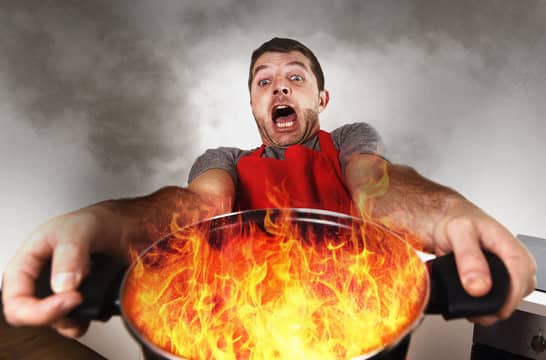Burnt Pot Smell: Is It Toxic? (Explained)
Are the Fumes from A Burned Stainless Steel Pan Harmful?
If we clean the burnt stainless-steel utensils properly it is safer to cook the food again in it. We should avoid cooking in damaged or burnt utensils, this can cause danger to the health and create various health issues.
The Author
Stainless steels are the type of metals usually made from the combination of many metals placed in layer form, but among the metals, only the stainless steel comes in contact with the fumes.
There are many types of stainless steel.
There is no such thing that is totally safe from radioactive exposure. This combination of various metals in layers makes it more stable as a particular utensil.
Stainless steel utensils have good resistance power from corrosion, oxidation, and rust, and also, the utensils made from stainless steel are very stronger in nature.
But these layered metals don’t make the stainless-steel utensils safe to be used for food preparation.
Chromium and nickel are toxic metals, and these metals may mix with the food and make the food toxin to be eaten.

What kind of stainless steel is safe to be used for cooking purposes?
High-quality stainless-steel utensils are expensive but are very safe to be used for cooking purposes that gradually resist the heat of the gas and therefore do not react with the food materials or release any harmful chemicals into the food that is being used prepared on that utensil.

It does have better resistance power towards the fact of discoloration and also getting eroded with time.
High-quality stainless steel products are induced with five layer-ply materials for construction with even heating power.
The melting point for stainless steel is more than 2500 degrees. If the fumes get stuck in the pan, this is a concern.
The fumes can release toxins and other hazardous elements, which can create dangerous body reactions among whoever is eating the food being prepared.
The illnesses may cause metal fume fever due to the reaction of overexposure to the heat, and thus the zinc oxide fumes cause the illness.
In actuality, stainless steel is the safest utensils to prepare healthy foods.
These utensils don’t release any toxic or metallic flavor to the foods being prepared so that one can actually get the exact taste of the meal.
But anyhow the surface of the stainless-steel utensils gets scratched very deeply that can release metals like nickel and chromium into the food, although it is usually in small amounts.
These elements are not actually toxic elements, so there is no need for concern until and unless someone has those metal allergies.
However, if there is some sort of exposure to some metal fumes, such as cadmium, it can cause serious health issues and also death.
When the concern is about the burnt stainless-steel utensils, it is safe to be used until and unless the surfaced has got damaged or pitted.
But after cleaning the burnt stainless-steel utensils thoroughly we can again start using them later.
So, we should surely start cleaning the stainless-steel utensils as soon as it gets burnt.
Are the stainless-steel utensils get intoxicated when heated?
Usually, the stainless-steel utensils provide a good cooking surface that can resist heat, and don’t react with the food, fumes, or else leave the harmful chemicals into the food, thus making the food hazardous.

For the maintenance and Care of the stainless-steel utensils, It is very important to take care of the utensils very nicely, suppose like using a wooden spoon for the food preparation, that doesn’t let the surface of the utensil get degraded with use.
The utensils should be made from materials that won’t scratch the stainless-steel surface of the particular utensils.
What actually happens when stainless steel utensils are heated?
The metallic surface of the utensils expands, when heated and then the length, surface area, and volume increase with the temperature.
This action occurs because the heat reacts with the atoms of the metal, thus making it expand with the exposure of heat.

Thus, the ferromagnetic metals become less magnetic when they are heated up and therefore lose their magnetism power above their tolerating temperature.
Although aside from the radioactivity fact the kind of steel that is used in a maximum of the stainless steel is not of that much good quality in nature.
Most of the stainless-steel utensils, that are being sold in the stores are of such nature that allows the chrome and nickel elements to get mixed in the food and as the water, as well as the food chemicals, react with the walls of the utensils when they are heated up.
The effects of chrome and nickel metals cannot be eliminated. They can create serious health issues with time and more use.
The percentage of the use of metals such as chrome and nickel is actually what makes it stainless steel utensils together.
Whether the burnt fumes are toxic or not?
Stainless steel cookware are usually is made up of metal alloy comprising of mostly elements like iron and chromium with various other percentages of elements like molybdenum, nickel, titanium, copper, and vanadium, which is what actually makes stainless steel utensils thicker and most costly compared to those of other utensils.

If we clean the burnt stainless-steel utensils properly it is safer to cook the food again in it.
We should avoid cooking in damaged or burnt utensils, this can cause danger to the health and create various health issues.
If the stainless-steel utensils usually get scratched up or get damaged deeply, we can repair them and use the utensils again without any further problems and knowing the best way out to cook in the stainless-steel utensils.
If the cookware we are using is toxic in nature then this will surely lead to health hazards, even if we are following a good and very healthy diet.
So utensil choosing part is most important when cooking at home is considered.
